|
Tagging North Atlantic Right Whales
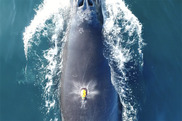
We recently teamed up with whale researchers at the Ocean Alliance to use drones to attach suction-cup tags to endangered North Atlantic right whales off the coast of New England. While this tagging method isn’t new, it is the first time it’s been used for tagging right whales. More here on how this tagging method holds promise as an effective and less-invasive way to collect data and give us a fuller picture of biological and ecological factors contributing to their population decline.
|
IN FISH Interns Share Their Insight
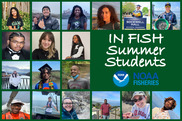
This year, 18 of the 50 students we hosted participated in the Inclusive NOAA Fisheries Internship program. These students hail from nine states and U.S. territories and 18 different colleges and universities in 10 states and U.S. territories. Project topics ranged from climate science, protected species, fisheries, and offshore wind to science communication, vulnerable marine ecosystems, Indigenous practices, and recreational fishing. Meet the students, learn about their research projects, their internship experience, and more here!
|
Stellar Spring EcoMon Survey
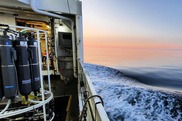
The spring 2023 Ecosystem Monitoring Survey has finished and it was stellar! The research team completed 100 percent of the planned research activities at 222 stations and collected supplemental data. It was a full 21 days at sea with great weather and efficient crew and command aboard the NOAA Ship Henry B. Bigelow. This survey helps researchers understand and predict changes in the Northeast shelf ecosystem and its fisheries. Our core sampling provides data that help us understand things like ocean acidification and changes in water temperature, salinity, the distribution and abundance of zooplankton and larval fish, and more.
|
Shellfish Farming Gear Provides Habitat for Fish
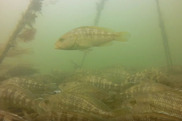
Our GoPro Aquaculture Project shares their findings in a new video “Home Sweet Oyster Farm.” In 2017, scientists at our Milford Lab began investigating reports that oyster growers were seeing fish in and around their aquaculture gear. They partnered with Long Island Sound growers to place oyster aquaculture cages mounted with GoPro cameras on their farms. After collecting and analyzing more than 1,600 hours of underwater footage, scientists observed 21 species of fish on gear, exhibiting behaviors associated with habitat use, and in similar or greater abundance as on natural habitat. The team is working with regulators to integrate their data into the aquaculture permitting process.
|
2023-2024 Northeast Observer Sea-Day Schedule Available
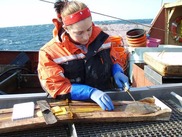
NOAA Fisheries has released the 2023-2024 sea-day schedule for commercial fishing trips selected for observer coverage. Three new information reports that support the schedule are also available. Reports include information on:
- The methodology used to develop discard estimates and sea days needed to obtain estimates
- Summarized discard estimates, number of sea day to achieve statistical standard for fleets, and number sea days allocated to each fleet
- How fishing trips are selected for coverage and number of observer days allocated
The schedule and supporting reports can be found here.
|
Fishermen Supporting Fisheries Research
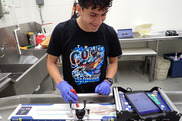
Our Cooperative Research Branch’s Industry Based Biological Sampling Program partners with fishermen to collect biological samples for research that can be used to improve our understanding of marine ecosystems and to manage fisheries sustainably. This year, they collected 5,163 samples from 11 species, supporting six science center-led and four external research projects. The program provides a valuable opportunity to collect biological samples in locations and at times of year that are critical to the life histories of commercially important species. The recent longfin squid biological sampling project requires the help of three to four commercial fishing vessels collecting 300 to 400 longfin squid weekly for 2 years.
|
Initiative Supports Student Research at Howard Lab
Ensuring a Safe Work Environment for Observers

On September 19, 2023, NOAA Fisheries and the Office of Law Enforcement will host a workshop for fishing industry members to help answer common questions about harassment and sexual assault/harassment, and to further support observers in the field. Workshops are voluntary and the topics will include: what constitutes harassment, how to communicate safety-related concerns on a particular vessel, how NOAA's Office of Law Enforcement plans to follow up on reports, and more.
|
Woods Hole Science Stroll a Success
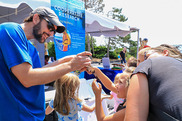
The Woods Hole Science Stroll is an annual outdoor open house hosted by all the major science institutions and their partners in Woods Hole, Massachusetts. Back for the first time since 2019, the stroll attracted more than 1,000 visitors to the village on August 12. At our laboratory, three ships were open for tours: the U.S. Coast Guard’s rescue vessel, the commercial sea scallop F/V Saints and Angels homeported in New Bedford, Massachusetts, and our own R/V Gloria Michelle. Other highlights included hands-on demonstrations focused on the human side of fisheries, and on fishery observing, fish biology and aging, water chemistry, Atlantic salmon, and cooperative research programs with the commercial fishing industry. Drones, our HabCam, and our newest autonomous underwater vehicle were also on display, as well as an inflatable whale and a life-sized model of a leatherback turtle.
|
Director’s Message
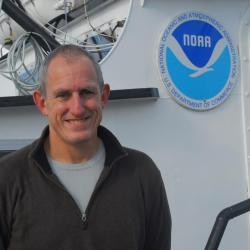
We’re working with NOAA Fisheries to promote ocean co-use and protect biodiversity as the offshore wind energy industry grows. Here’s an update on how we’ve been addressing the challenges and opportunities.
Federal Surveys
It’s clear offshore wind energy development will affect our federal surveys because our ships and aircraft that conduct the work are not able to operate in the lease areas as they have in the past. This potentially creates gaps in our databases, which are essential to understanding the status of species and marine ecosystems in our region. To address this we’ve:
- Developed a survey mitigation strategy with the Bureau of Ocean Energy Management
- Formed a joint implementation team with BOEM
- Started work to incorporate elements of the mitigation strategy into the terms and conditions of BOEM’s offshore wind project approvals.
- Started drafting survey-specific mitigation plans for all 14 of our impacted surveys using information from our recently released Synthesis of the Science report.
New Directions for Monitoring OSWE Effects on the Ecosystem
Another key focus for us is to develop new methods and plans for monitoring change in the environment as wind energy develops.
We collaborated with the Woods Hole Oceanographic Institution on a way to continue surveying Atlantic sea scallop populations in wind energy areas. We’re thrilled that we’ve completed the first sea trials on a new long-range autonomous underwater vehicle that can operate in the lease areas. This vehicle carries HabCam—a stereo camera and sensor system that is also used during our federal scallop survey. The AUV is small, has all the necessary sensors and equipment used for surveying scallops, and can be programmed. It's an excellent option for collecting the data and information we need inside wind energy lease areas.
We’ve also evaluated environmental monitoring planned by wind developers for their projects. We found that as currently designed, developer monitoring will not yield information to mitigate data lost from federal surveys in offshore wind energy areas. To help wind developers enhance their monitoring plans, we’ve provided a series of recommendations. These recommendations will also contribute to improved regional understanding of fishery resource responses to wind development.
Looking Ahead
Our staff participated in an International Council for the Exploration of the Sea Workshop on a Research Roadmap for Offshore and Marine Renewable Energy. Next month, ICES will hold their annual science conference. We are co-conveners for a session on the ecosystem science needed to support a new era of offshore marine renewable energy.
As always, we remain committed to working with a wide range of partners and collaborators to provide the best available scientific information and tools necessary for productive, sustainable, and healthy marine ecosystems and coastal communities in our region.
|
|
|
Upcoming Events and Meetings
Aug 24: Black sea bass working group meeting
Aug 28: Yellowtail flounder working group biology meeting
Sep 1, 15: Applying state space models working group meeting
Sep 5: Black sea bass working group meeting (modeling results discussion)
Sep 18–20: September management track peer review meeting
Sep 19: Ensuring a safe work environment for observers workshop
Sep 30: Milford Lab Open House
|
|
Upcoming Deadlines
Sep 4: National Marine Sanctuaries annual photo contest
Sep 21: NOAA climate services delivery public comment
Oct 31: NOAA Fisheries 2024 Species Recovery Grants to Tribes
Rolling: 2024 Veterinary Aquaculture Research and Policy Fellowship applications
|
|
|
|
|